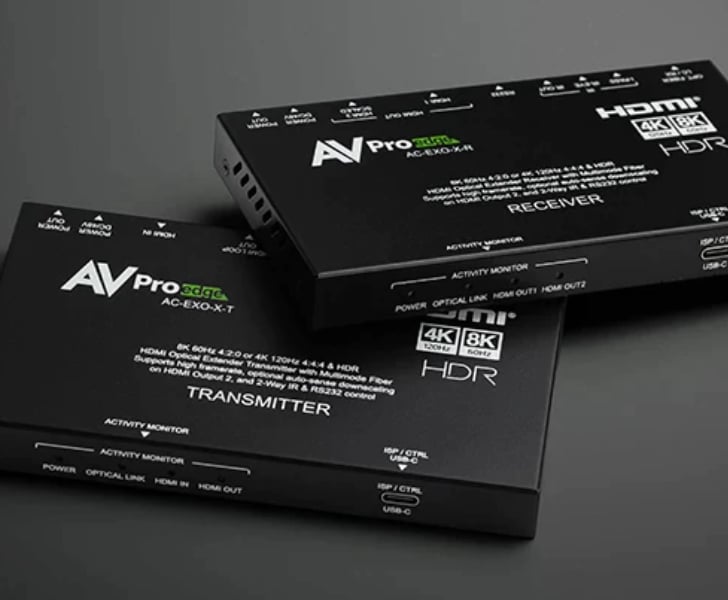In the ever-evolving world of audio-visual technology, staying ahead of the curve is crucial for businesses and AV professionals alike. As a leading distributor of specialist audio-visual products in Australia and New Zealand, we at Audio Visual Distributors are constantly monitoring the pulse of the industry. In this blog post, we’ll explore some of the key trends shaping the future of AV solutions, helping you make informed decisions for your projects and installations.
1. The Rise of AV over IP
One of the most significant shifts in recent years has been the move towards AV over IP (Internet Protocol) solutions. This technology allows for the transmission of high-quality audio and video signals over standard network infrastructure, offering unprecedented flexibility and scalability.
Key Benefits:
– Reduced installation costs
– Greater flexibility in system design
– Easier scalability for future expansions
– Enhanced integration with IT systems
As networks continue to improve in speed and reliability, we expect AV over IP to become the standard for most large-scale installations.

2. AI and Machine Learning in AV Systems
Artificial Intelligence (AI) and Machine Learning (ML) are no longer just buzzwords; they’re becoming integral parts of modern AV systems. These technologies are enhancing user experiences and simplifying system management in numerous ways:
– Automated Room Setup: AI can adjust audio and video settings based on room occupancy and ambient conditions.
– Predictive Maintenance: ML algorithms can predict when equipment might fail, allowing for proactive maintenance.
– Enhanced User Interfaces: AI-powered voice control and natural language processing are making AV systems more intuitive to use.
As these technologies mature, we anticipate seeing even more innovative applications in the AV space.
3. The Importance of Collaboration Technologies
The global shift towards hybrid work models has placed a spotlight on collaboration technologies. Modern AV solutions need to bridge the gap between in-person and remote participants seamlessly.
Key Features of Modern Collaboration Systems:
– High-quality audio and video for clear communication
– Easy content sharing from multiple devices
– Integration with popular video conferencing platforms
– Support for BYOD (Bring Your Own Device) scenarios
The demand for these technologies is likely to continue growing as organisations adapt to new ways of working.
4. Immersive Experiences with AR and VR
Augmented Reality (AR) and Virtual Reality (VR) are pushing the boundaries of what’s possible in AV installations. While still in the early stages of widespread adoption, these technologies are showing promise in various sectors:
– Education: Immersive learning experiences
– Corporate: Enhanced virtual meetings and training simulations
– Entertainment: Interactive exhibits and virtual tours
– Retail: Virtual product demonstrations and try-ons
As AR and VR technologies become more accessible and user-friendly, we expect to see increased integration with traditional AV systems.
5. Sustainability in AV Design
Environmental concerns are driving a shift towards more sustainable AV solutions. This trend is manifesting in several ways:
– Energy-Efficient Hardware: Modern AV equipment is designed to consume less power without compromising performance.
– Smart Power Management: Systems that automatically power down unused equipment to conserve energy.
– Eco-Friendly Materials: Manufacturers are increasingly using recyclable materials in their products.
– Remote Management: Reducing the need for on-site visits through advanced remote monitoring and control capabilities.
Sustainability is no longer just a nice-to-have; it’s becoming a crucial factor in AV system design and product selection.
6. The Growing Importance of Cybersecurity
As AV systems become more networked and interconnected, cybersecurity is an increasingly critical concern. Protecting AV installations from potential breaches is now a fundamental aspect of system design and implementation.
Key Cybersecurity Considerations:
– Secure network design
– Regular firmware updates
– Strong authentication protocols
– Encrypted data transmission
AV professionals need to work closely with IT departments to ensure that AV systems meet organisational security standards.
Conclusion: Embracing the Future of AV
The AV industry is at an exciting crossroads, with new technologies and trends constantly emerging. As a leading distributor of specialist audio-visual products, we at Audio Visual Distributors are committed to staying at the forefront of these developments. Our team of experienced professionals is always ready to help you navigate these trends and find the best solutions for your specific needs.
Whether you’re looking to upgrade your existing AV infrastructure or embark on a new installation, it’s crucial to consider these emerging trends. By embracing innovative technologies and forward-thinking design principles, you can create AV solutions that are not only cutting-edge today but also adaptable for the challenges of tomorrow.
Remember, the key to success in the world of AV is not just about having the latest technology; it’s about implementing solutions that enhance communication, improve efficiency, and create memorable experiences. With the right partner and a clear understanding of industry trends, you can achieve all of this and more.
Ready to take your AV solutions to the next level? Contact Audio Visual Distributors today, and let’s shape the future of audio-visual experiences together.



